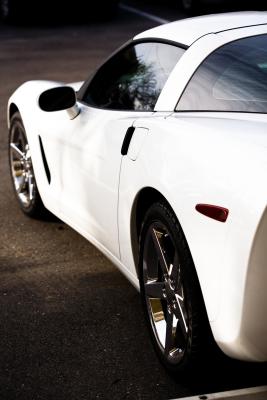
Aluminum driveshafts may seem like an expensive gimmick to some, but they do offer a number of tangible benefits. The aluminum shaft's decreased mass yields numerous benefits in terms of performance, performance potential and safety. Whether or not it's worth the cost depends primarily upon your application -- the car, the powertrain and how you intend to use it.
Light weight is the aluminum driveshaft's reason for existence. A driveshaft acts something like a very small but very long flywheel, and like a flywheel, it takes a certain amount of energy to overcome the driveshaft's inertia. Where acceleration is concerned, inertia translates to horsepower lost to spinning the shaft instead of moving the car. Most of that acceleration loss comes just off the starting line, when the engine has to overcome the heavy driveshaft's initial resistance. While the aluminum shaft may only be worth 0.01 to 0.10 second in the quarter-mile, most of that comes in those crucial first 60 feet.
No driveshaft is perfectly balanced or straight, particularly at high speed and under heavy acceleration. This is particularly true of very long driveshafts, which will bow or twist more than shorter ones. The faster the shaft spins, the more its initial imbalance causes it to bend, and the farther it goes out of balance. The aluminum driveshaft's weight advantage comes into play here as well. Lower mass means less potential imbalance in the center section, which consequently translates into less bowing at high rpm. Smoother acceleration and high-speed rotation is a benefit in and of itself, but the reduced vibration can also help to extend the life of universal joints, transmissions and differential gears.
All driveshafts have a critical speed, an rpm limit after which the driveshaft will resonate and twist or vibrate out of control. Two primary factors dictate the shaft's critical speed: its length-to-diameter ratio, and its mass. At high rpm, a long, skinny, heavy driveshaft will resonate and start to whip around under the car like a snake. Aluminum has two advantages here. The first and most obvious has to do with its weight advantage, while the second concerns its dimensions. Doubling the weight of a rotating mass doubles its inertia, while doubling the diameter of that mass quadruples inertia. Aluminum's lower weight allows for a thicker driveshaft that will remain stable at high speed but won't unduly impact acceleration via increased inertia.
Aluminum driveshafts, like most lightweight drivetrain components, tend to deliver the greatest results on lighter cars with less-powerful engines. Reducing weight in a heavy car is always good for performance, but you have to look at the mass removed as a percentage of the whole. Removing 10 pounds of rotating mass from a car with 50 total pounds of rotating mass is going to have a far more noticeable effect than removing that same 10 pounds from a car with 100 pounds of rotating mass. The same goes for power; less powerful engines, or those limited in power by racing class restrictions, are going to derive more benefit from a lighter driveshaft than more powerful ones.
A quality aluminum driveshaft is just as strong or stronger than a standard steel equivalent of the same weight, but there are other options available if you've got the money. Chrome-moly steel is the material of choice for many professional racers. While expensive, chrome-moly is extremely strong, which means that it can come in at about the same weight as a standard steel driveshaft but resist twisting and bending at far higher power levels and rpm. If you've got nothing but money, you might look into a carbon fiber driveshaft. Carbon fiber is stronger than steel by weight, offers twice the wheel horsepower gains as aluminum, delivers instant throttle response and the highest critical speed of any material.